-
solutinos
-
Hire
Frontend Developer
Backend Developer
-
NodeJS Developer
-
Java Developer
-
Django Developer
-
Spring Boot Developer
-
Python Developer
-
Golang Developer
-
Ruby on Rails Developer
-
Laravel Developer
-
.NET Developer
Technology
-
Flutter Developer
-
React Native Developer
-
Xamarin Developer
-
Kotlin Developer
-
Cross-Platform Developer
-
Swift Developer
-
MongoDB Developer
-
C Developer
-
Smart Contract Developers
Cloud
-
-
Services
Mobile Development
Web Development
- Work
-
Multi Services App
-
Food Delivery App
-
Grocery Delivery App
-
Taxi Cab Booking App
-
Multi Services App
-
OTT Platform APP
-
Social Media APP
-
Freelance Service App
-
Car Rental App
-
Medicine Delivery App
-
Liquor Delivery App
-
Sports Betting App
-
Online Coupon App
-
eLearning App
-
Logistics & Transportation App
-
Courier Delivery App
-
On-Demand Real Estate App
-
E-Wallet APP
-
Online Dating App
-
Handyman Services App
-
-
Process
-
Company
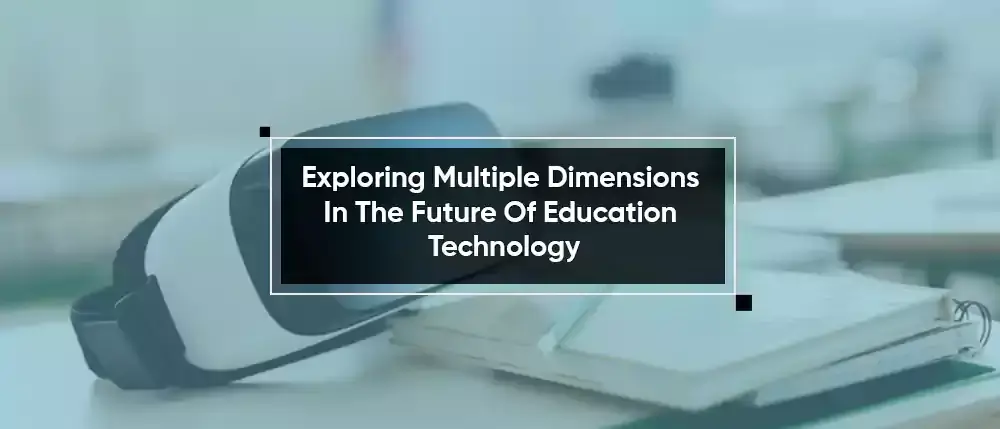
The education sector is full of possibilities. It has the power to transform the future and bring in a wave of revolution. But for that to happen, the loopholes and challenges need to be addressed today. And that's exactly what we did in our super exclusive Digital Transformations in Education Guide series .
Over the last eight posts, we have been sharing insights across diverse education aspects such as primary and secondary education , supplemental education , language schools , ancillary education sectors and more. We also shared sure fire tips on the features you need to include in your on-demand tutor app to make it stand out from the cloud.
We really believe you would consider the solutions we offered and take a wise decision in making the coming months and years profitable and take your students towards excellence. Only when the current challenges are fixed that we could be game changers for tomorrow.
And what is that tomorrow all about? Well, we are about to find out on this (last) post of our series. We especially hate it when we are on the verge of bidding farewell to our readers when there are so many topics to explore and recommend. But all good things have to come to an end.
If you're someone looking to build an institution for tomorrow and wondering how to go about it, we recommend getting in touch with us for a detailed conversation. And to help you get started and offer you some ideas on what the future looks like for education technology, we have compiled a few aspects.
Let's individually check out what they are.
The Future Of Education Technology
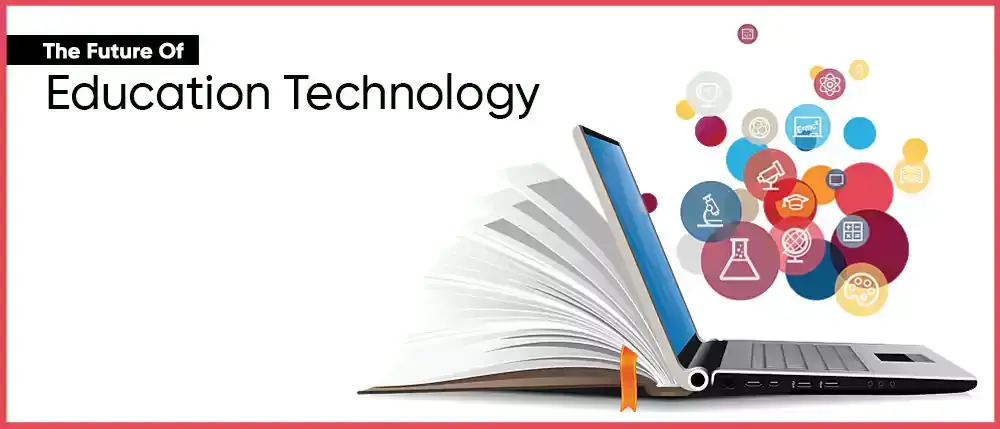
AR and VR In Education
Abbreviated as Augmented Reality (AR) and Virtual Reality (VR), these are being hailed as the future of education technology. If you notice, these technologies are currently being implemented in sectors like entertainment and healthcare for immersive experiences. But experts and several institutions across the globe vouch for the potential of AR and VR in classrooms.
To give you a detailed idea of each, let's explore them individually.
AR In Education
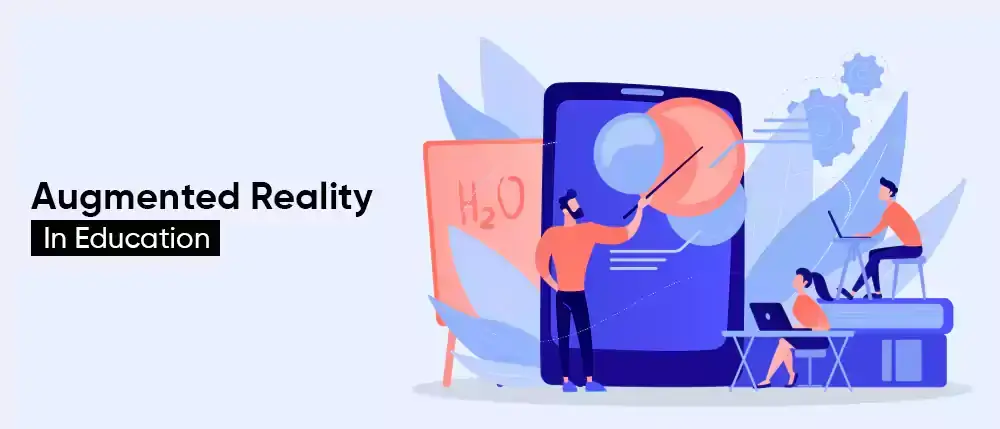
AR is the most practical technological concept of the two as it does not involve the requirement of a wearable device to experience its awesomeness. We are sure that most of us would have already experienced AR in our everyday life by now. From apps like Pokemon Go to Google Lens, AR technology is all about leveraging the potential of a device to its maximum to offer an experience like no other.
AR technology uses the device's camera, location-based services, internet, graphics, visuals, audio elements and more to superimpose entities that don't exist in the real world but only on device screens. In education, AR can do wonders by bringing to life some of the most complicated concepts and topics such as Rutherford experiments, uncertainty principles, biological processes, World War II and more through videos, graphics and interactive features on the screens of students' devices.
With AR, students can get up, close and personal with historical figures, civilizations, personalities, organs of the body and more and make way for improved retention rates. The best part is that a custom AR app can be developed by institutions to offer unique experiences relevant to their students alone. This ensures their programs and course curriculum can be explained better with a competitive edge.
Not just in schools, AR can be used in supplemental education and language schools as well. Vocational courses can offer a virtually hands-on experience of real-world scenarios through AR apps.
Virtual Reality
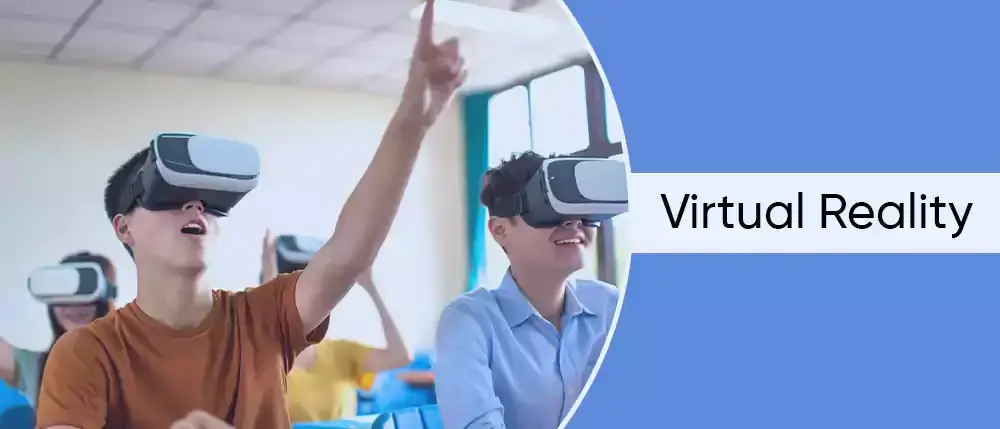
Though VR needs a wearable device, the experience it offers to students and aspirants is way beyond what AR could offer. While AR is two-dimensional in terms of experience, VR is 3-dimensional. Students could be part of a new environment through virtual surroundings and environments and become active participants in a scenario.
If students could watch the construction of the Eiffel Tower in AR, students could travel virtually to the time period, interact with construction workers, stimulate their senses and do more in VR. In vocational courses, students can even work on a problem and solve them virtually as simulations before they get hands on with real-world problems.
The best aspect of virtual reality is that students would have personalized experiences, working on their individual abilities like perception, imagination, problem-solving skills, analytical skills and more. This would be ideal to assess their strengths and weaknesses and inculcate in them skills they are interested in.
Other Benefits of AR and VR
- These technologies can eliminate language barriers and help students learn in a language they are comfortable in.
- Self-paced learning can get a new definition with AR and VR technologies.
- They help students focus better on learning and completely removes the concept of rote learning.
- Learning by practice is the biggest USP in implementing AR and VR in education.
Despite being so interesting and rewarding, it should be noted that virtual reality is far from being practical in classrooms as statistics reveal that close to 93% of the teachers across institutes are interested in VR but only 6.7% of them use the technology regularly.
Adaptive Learning
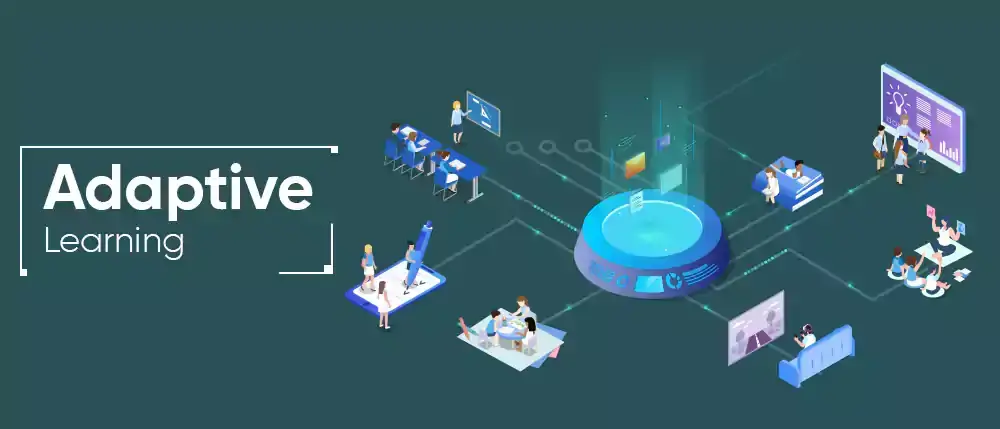
One of the biggest concerns in education is that it currently follows a one-size-fits-all approach in teaching and learning. Education was never supposed to be objective. Because not all kids have the same skills, abilities, pace, and learning habits, placing a collective goal or an outcome only discourages students who take time to understand a few concepts or topics. It causes unnecessary stress and self-doubt that is totally unrequired in their age group.
That's exactly why we advocate adaptive learning in institutions, where students get to learn at their natural pace and understanding capabilities. Instead of teachers pulling students towards a preset vision, students should be allowed to explore their way through learning. And for that to happen, technologies like Artificial Intelligence (AI), Machine Learning (ML), data science and more have to be deployed on learning management systems, school management portals and applications.
But What Exactly Is Adaptive Learning?
For the uninitiated, adaptive learning is where algorithms understand the pace and capabilities of students from their activities, assessments, online activities and other data touchpoints to suggest personalized learning curves, pathways, lessons, lesson plans, assessment questions and more to help students make the best of their learning time.
With adaptive learning, the goals are individualistic and the students are competing against themselves. They are trying to become better versions of themselves. For instance, when the algorithm detects through touchpoints that a student is good at English grammar but struggles with algebra, it would recommend more content on algebra from multiple sources, suggest a good learning plan, appropriate levels of assessments, revisions and more to ensure the student becomes better at algebra as well.
With detailed analysis and visuals, the pathways are laid out for students, teachers and parents to have a look and understand progress. With this, students gain more confidence and become better at problem solving instead of getting stressed over the fear of being incapable. This entire system encourages students based on their strengths and helps them work on their weaknesses through the most subtle and positive ways possible.
Education technologies based on AI
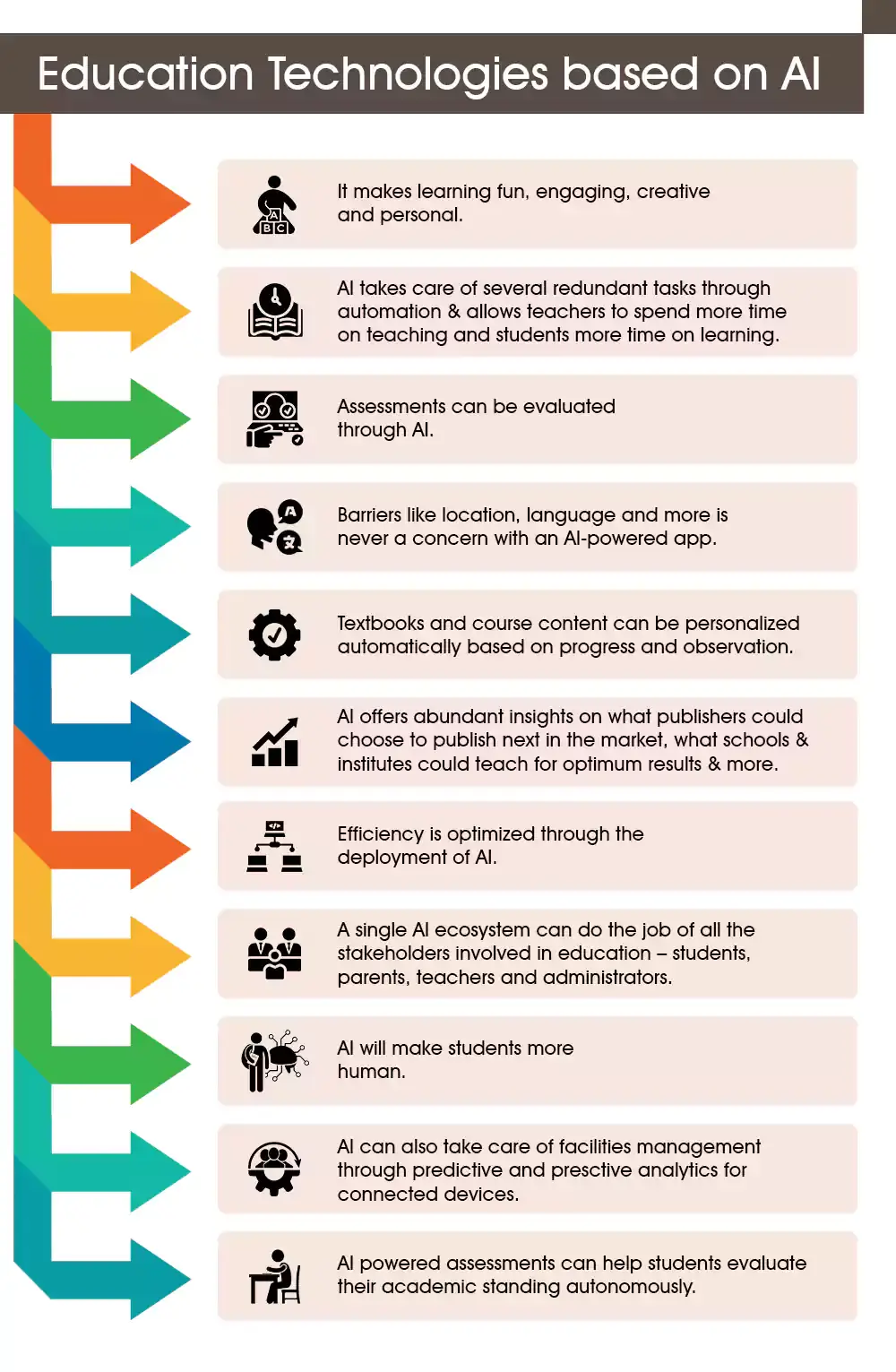
Until sometime back, AI was seen as an agent of doom. People all over the world viewed AI as a dystopian element that is generated to cause destruction. But as people started experiencing the potential of AI, especially across segments like healthcare, retail, supply-chain, education and more, they started gaining confidence on this technology.
Today, there is hardly any industry or segment that isn't influenced by AI. Even the futuristic tech concepts we discussed so far are powered by artificial intelligence. The core element in adaptive learning is AI and its associated algorithms and bots. Interactive whiteboards are powered by AI and even the education apps deploy AI for optimum user experience.
However, there still seems to be a lot of misconception around the implementation of AI for education purposes. So, let's look at some of the practical problems AI is designed to solve.
- It makes learning fun, engaging, creative and personal.
- AI takes care of several redundant tasks through automation and allows teachers to spend more time on teaching and students more time on learning.
- Assessments can be evaluated through AI.
- Barriers like location, language and more is never a concern with an AI-powered app.
- Textbooks and course content can be personalized automatically based on progress and observation.
- AI offers abundant insights on what publishers could choose to publish next in the market, what schools and institutes could teach for optimum results and more.
- Efficiency is optimized through the deployment of AI.
- A single AI ecosystem can do the job of all the stakeholders involved in education – students, parents, teachers and administrators.
- AI will make students more human.
- AI can also take care of facilities management through predictive and presctive analytics for connected devices.
- AI powered assessments can help students evaluate their academic standing autonomously.
Thanks to these benefits (and more), experts forecast that the adoption of AI in education will grow more in the coming months and years.
5G Technology In Education
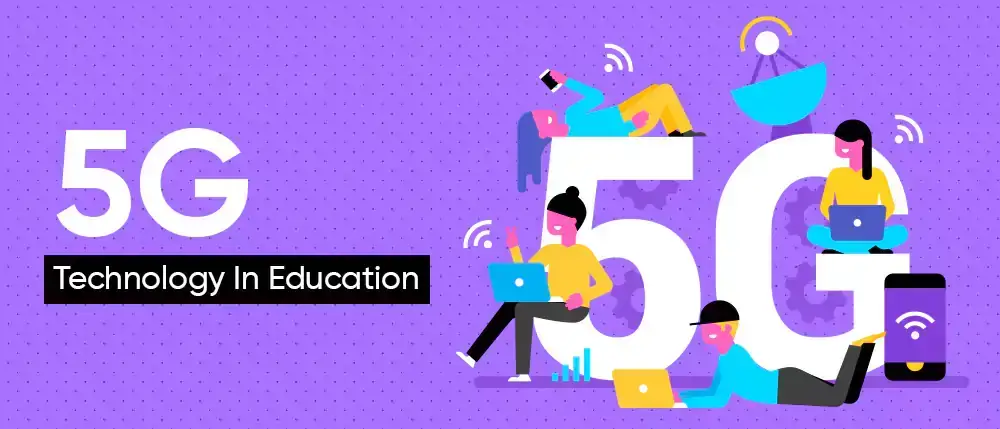
With the world going digital at rapid rates, what it simultaneously needs is the tech and infrastructure to support this massive adoption. Concepts like smart cities, smart power grids, automated traffic controls, smart institutes can only become realities when concerns relating to connectivity are removed.
And to deal with the increasing complexities involved in wireless technology is arriving on the next generation of internet with its 5G technology. Believed to revolutionize the world with its speed, accurance, latency and bandwidth, experts are already going bonkers over the tech's potential.
But 5G still remains a futuristic concept as more details are yet to surface on the exact time 5G will be rolled out across the globe. When 5G rolls out, the benchmarking standards will be rattled and newer devices with advanced potentials that are 5G-ready will be launched as well. Collectively, there would be progress and evolution, a major chunk of which will be experienced in the education sector as well.
The internet is becoming more of a necessity than luxury in several institutes and as the market penetration of the internet deepens, schools and institutes would need perpetual internet connectivity to deal with tasks and challenges. With 5G, this won't be a problem as it is designed to make connectivity seamless for all connected users.
5G would also support concepts like the Internet of Things, where all devices are connected together over the internet for the transmission of data and information. With connected devices and bots becoming essentials, 5G would be inevitable in education and institutions.
As technologies like AR and VR become more prominent, 4G powers wouldn't be enough to support bulk usage of the internet's bandwidth. In that case, 5G is the only savior. 5G also eliminates buffering with its higher data-carrying capabilities, meaning students can explore multiple learning methodologies to understand concepts.
Though this is too early to accurately forecast the role of 5G in education, we highly believe that the problems it would solve would be mostly on the grassroots level.
Automation

Contrary to popular opinions, automation isn't here to gobble up jobs. In fact, it is here to create new and advanced job roles for aspirants and the current talent pool. The role of technology has always been to simplify tasks, eliminate manual intervention wherever possible and elevate lifestyle. Automation takes care of all these seamlessly.
In education, especially, automation can help all the stakeholders save ample time on diverse redundant tasks they perform on a daily basis. To give you a detailed idea of what automation could do in education, let's look at some practical use cases.
- Automation can optimize admissions and enrolment processes through automated email responses, bots to answer queries and interactions.
- It can help sales and marketing associates promote institutions, academic books and courses better.
- Meetings, follow ups and reminders could be scheduled automatically.
- Planning of resources, lessons, timetables, rosters and more can be automated.
- Teachers can automate the process of taking attendance every day.
- Students can perform better through automated assessments and evaluations.
- Administrators can save ample time through the automation of invoicing, payouts, payroll management, facilities maintenance, servicing scheduling and more.
- Automation paves the way for individual attention from teachers as they have more time getting to know the individual strengths and weaknesses of their students through adaptive learning techniques.
- Automation is no less than a blessing in the education sector and the sooner institutions embrace automation, the more impactful their teaching would be.
Competency-based Education
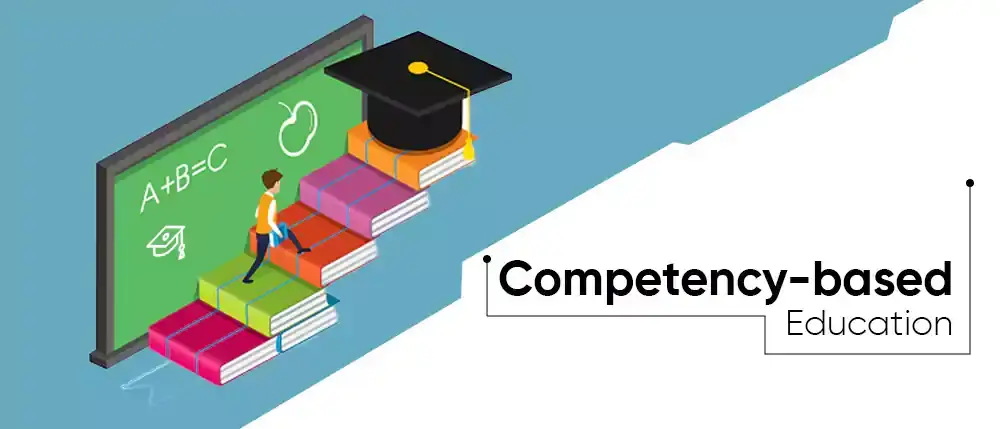
For a student to excel, they should not show an understanding of a topic or a subject but mastery over it. Mastery is something that is becoming inevitable currently and employers across the globe focus on not what students and aspirants know but how good they are at something.
For that, we need another layer to adaptive learning and thankfully, it exists in the form of competency-based education.
In this, students are recognized for the skills or understanding of topics outside their regular academics. This is done through pre- and post-assessment techniques. Based on the results, students are offered complementary education that further nurtures their other talents and innate competencies. With competency-based education, students can shift their focus from grades and ranks and focus on simply learning. Through repetitive feedback, they can take ownership of their skills and be more responsible towards their aspirations. This collectively gives rise to a talent pool that is independent, confident and mature.
Learning Analytics
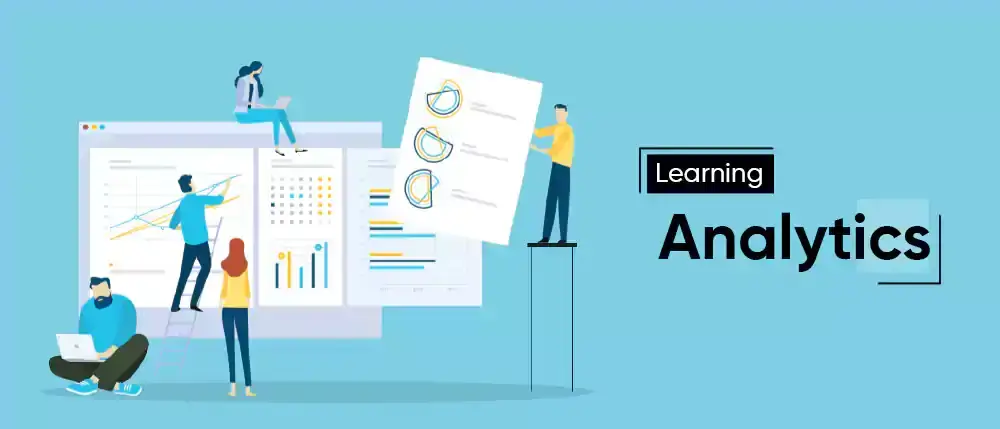
One of the major reasons why there exists a gap between industry requirements and academic qualification is because there are no solid analytics to let stakeholders know crucial parameters about students and aspirants. Methods of assessments are vague, the ways to compile results are outdated and even assessment metrics are obsolete. At any given point of time, a student should be visually able to see where they stand in their academic journey.
And this can happen only with technology and its offering called data analytics. As students continue to work on specialized learning management systems, apps and portals, the more the systems understand about them. And over a period of time, solid information on their tastes and preferences, likes and dislikes, strengths and weaknesses, abilities and potential and more could be presented to all stakeholders.
Analytics helps you find insights in the most unexpected areas. Consider attendance for instance. What could pass off as a regular case of absenteeism can have underlying motives. A student could be disinterested in days that has more hours of math or another particular subject. Or a particular day of the week could be a test day that the student dreads.
In such cases, the student takes leave. On journals and offline methods, this could be something regular and unharmful. But with analytics, this is a pattern that administrators and teachers could notice to talk with students, optimize their teaching methodologies, come up with engaging classroom sessions and more.
The most advantageous part of learning analytics is that clean graphs, charts and visuals are offered to stakeholders in languages they can understand. One look at them and stakeholders can understand what is wrong and what is right. And because analytics and insights are available perpetually, taking corrective measures at the right time is never a concern.
Gamification
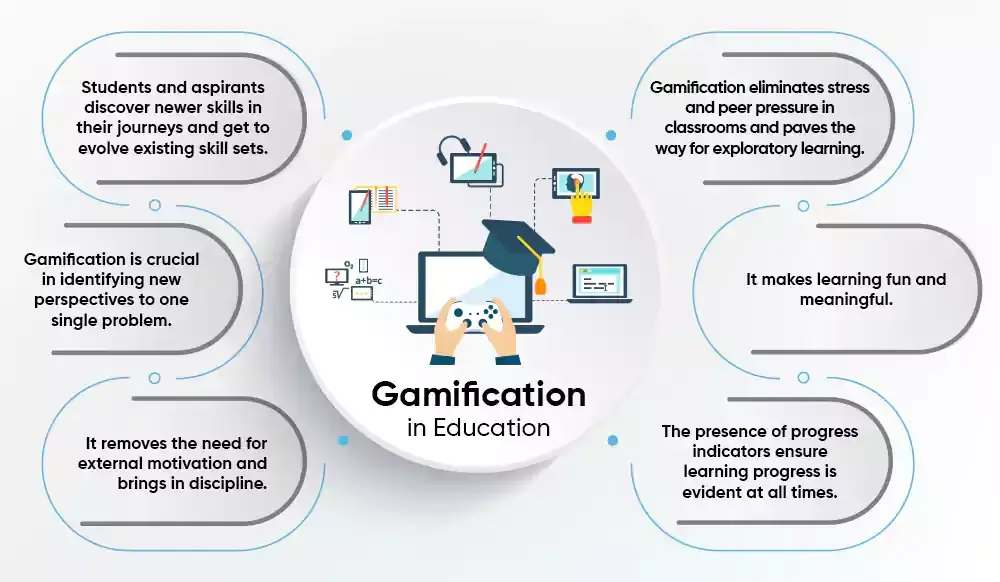
Gamification is here to stay and make the lives of everyone better. Wait, this statement is backed by statistics. Close to 80% of people who experienced gamification reveal that it has motivated them.
In simple words, gamification is the concept of challenges and rewarding systems in education to motivate students and enable better learning and outcomes. Gamification puts learning in the hands of students and lets them take ownership of their challenges and shortcomings.
Gamification replaces challenges with accomplishments and grading and marks with rewards and experience points. It takes inspiration from concepts you would encounter in video games and puts them in real-world scenarios to empower students.
To give you more ideas on what gamification is capable of, check out the pointers below.
- Gamification eliminates stress and peer pressure in classrooms and paves the way for exploratory learning.
- It makes learning fun and meaningful.
- The presence of progress indicators ensure learning progress is evident at all times.
- Students and aspirants discover newer skills in their journeys and get to evolve existing skill sets.
- Gamification is crucial in identifying new perspectives to one single problem.
- It removes the need for external motivation and brings in discipline.
A gamified classroom or an institute is more cheerful, interactive and engaged. But to ensure these, the institutes have to only take care of the deployment of an ideal gamification solution.
Blockchain-based Certificates
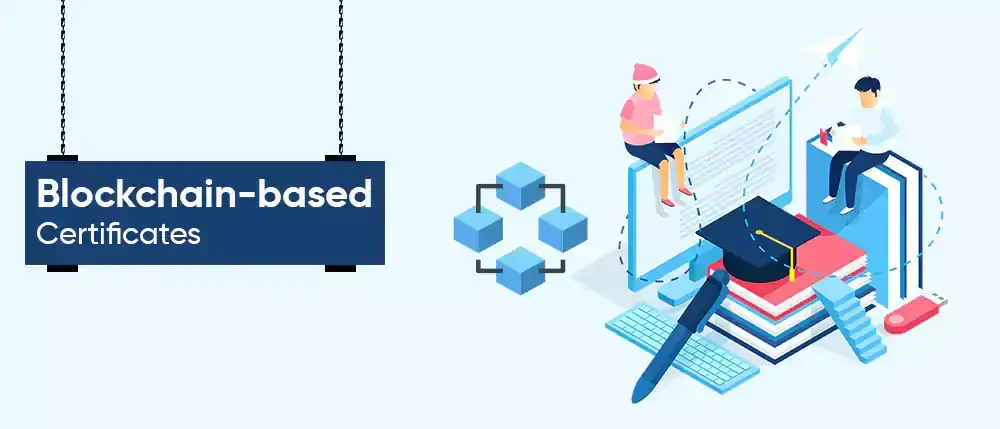
One of the reasons blockchain is presented as a futuristic technology because it is a concept that bewilders adults and experts. Full-fledged application of blockchain is awaited in several industries. In education, it could take some more time as the needs have to be realized or created.
One of the futuristic applications of blockchain we are looking at is the issuance of certificates that are based on blockchain technology . As learning becomes more personal and subjective, the associated metrics and progress become confidential as well. In such cases, only blockchain could bring in a discrete and tamper-proof environment in institutes.
Students with their unique Ids can access their blockchain-based certificates and make requests for amendments and modifications. Stakeholders can deploy blockchain as well to initiate smart contracts , prepare invoices and more.
Wrapping Up
We are all excited for the coming years as they would bring in revolutionary changes in the education space. With everything boiling down to the welfare of teachers and students, the deployment of tech in your infrastructure only makes more sense.
If you intend to be part of the revolution and plan for tomorrow today, we urge you to get in touch with us and discuss possibilities and ideas. We could help you launch exclusive educational apps for kids, digital learning apps, ERPs, learning management systems, student portals and more.
Together, let's change make education more enriching and accessible to the future generations.
Reach out to us today.